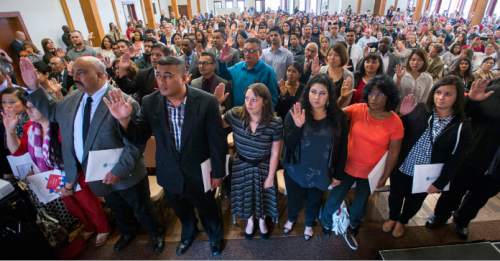This is an archived article that was published on sltrib.com in 2016, and information in the article may be outdated. It is provided only for personal research purposes and may not be reprinted.
While GOP presidential nominee Donald Trump pushes for a wall along the border, a new Pew Research Center study says a yearslong trend continues of more Mexican immigrants returning home than entering the United States.
Utah may be bucking that trend. An improving economy and reviving construction industry here are fueling new immigration, but officials are unsure how much of it is from undocumented immigrants.
Still, "Those are indicators that Hispanics are probably not leaving the state at this point, and there is a good chance that we are beginning to see some return immigration of some of the folks who had to leave because their jobs were gone," said Pam Perlich, director of demographics at the University of Utah's Kem C. Gardner Policy Institute.
Pew released a study Thursday about how the growth and dispersion of the U.S. Latino population has slowed since the onset of the Great Recession. Some of the data may counter some conventional wisdom about Hispanics here — including that only a third of Utah Latinos are not citizens, and now one of every five school children in the Salt Lake metro area is Hispanic.
The biggest headline from the study is that immigration continues to have reversed toward Mexico since 2009 when the recession hit and jobs became scarce.
Census Bureau surveys show that between 2007 and 2014 the U.S. Hispanic population grew by only 2.8 percent a year, according to the report. That's a big drop — down from the 5.8 percent annual rate that occurred in the 1990s when big waves of immigration occurred.
While Hispanics were once the nation's fastest growing population, they have now slipped behind Asians (whose population grew at an average annual rate of 3.4 percent from 2007 to 2014).
Perlich said net immigration to Utah is starting up again amid an improved economy and stronger construction sector, which especially had attracted Latinos previously. But research has not really looked at the source of Utah's recent immigrants. "They could be from California, Texas or other places. But they could be from Mexico, too," she said.
Tony Yapias, director of Proyecto Latino de Utah, said in his talks with local Latinos, "I haven't heard from a lot of people who say they are going back permanently," at least "not so much as we used to." He saw that many did return to their home country during the recession. "Some people went back and regretted it later."
But Yapias says what could indeed really fuel an exodus of Mexicans and Latinos from Utah is a win by Trump. "They hear Trump speak, and worry about what he may do. So they say they may go home."
Many who say that, however, face a dilemma because they live in "split families," where the parents may be undocumented but the children are U.S.-born citizens, said Yapias.
"Parents don't want to leave the kids, and the kids don't want to go to Mexico or someplace they have never been."
The new study includes some interesting statistics about Latinos in Utah and the Salt Lake metro area, for example:
• Only 35.5 percent of Hispanics in Utah are foreign-born.
• 74 percent of all Utah Latinos are now U.S. citizens — and the 26 percent who are not include both legal permanent residents and undocumented people.
"I think sometimes people in Utah have the perception that everybody's undocumented," Yapias said. But he adds the growing number of Latinos who are U.S. citizens is because of children born here to immigrant parents, who automatically become citizens.
• 21.9 percent of all school-age children are now Latino.
Perlich adds that the majority of students in the Salt Lake City School District are minorities. "Our educators are certainly aware of the changing composition of people in their classrooms," and how it may force changes in teaching.
• About 23 percent of all Utah Latinos speak "English less than very well."
• 53 percent of all Utah children living in poverty are Latino.
• Utah Latino households average only about 70 percent of the wages earned by others here.
Yapias said much of that may come from undocumented workers who are paid less or easily taken advantage of, and Perlich said it also is a result of many new immigrants struggling to gain footing in a new place.
Yapias said education can help improve those numbers, and President Barack Obama's decision to defer deportation of people brought to America as children to help allow them to attend college has made a big difference.
"Many of those 'dreamers' were able to go to college and more than double their income," he said.







